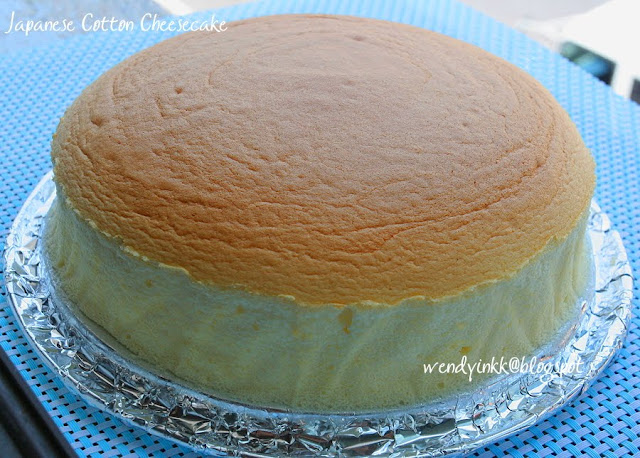Few months back, when I made Rainbow Piano Cake, there was a request for me to show how I make my buttercream. So, here it is.
Forget about those so called buttercreams at bakeries. They are laden with shortening or margarine. That's why they make your mouth feel so oily, with a waxy, plasticky film all over your tongue. Yucks!!!
But not this buttercream made with real butter.
1. It's light and creamy, and has a wonderful aroma. Almost like whipped dairy cream, slightly heavier in taste and texture. Provided you use fresh butter. Stale unsalted butter smell like Planta or even Dorina. Well, that is one of the reasons I don't consume margarine, I never like the smell and I never knew why. Now I know cos they smell like stale butter. Fresh butter smells like dairy cream, nice and good. This swiss meringue buttercream is not oily in the mouth, but your mixing bowls still need to be cleaned with either hot water or wiped with tissue to ease cleaning.
2. This buttercream also is not sweet like those simple buttercreams where you only beat butter with icing sugar. Ratio of sugar to butter is much lesser than simple buttercream and you can make more icing with this amount of butter than tradtional buttercream. Saves you money.
3. It also holds up well in our room temperature. If you want it to hold up longer, don't beat it too much at step (3), 5-6 minutes will be good. 8-10 minutes you will have a very fluffy icing, but one with less capacity to hold at +30C for long periods of time. My MIL left the cake overnight in the cabinet and the cream was still there, not melted, didn't even budge.
Swiss Meringue Buttercream
Recipe Source: Tartelette
Ingredients:
60gm egg white (about 2 large whites)
100gm sugar
170gm unsalted butter (taken out from fridge and cut into 10-12 small pieces just before you start to heat the egg whites)
Method: (instructions are adapted to tropical weather and hand held mixer)
1. Put the sugar and egg whites in a large heatproof bowl over a saucepan of simmering water and whisk constantly, keeping the mixture over the heat, until it feels hot to the touch, about 3 minutes. The sugar should be dissolved, and the mixture will look like marshmallow cream.
(egg whites in buttercreams are safe for consumption once it reaches 65C, to know how much is 65C w/o a thermometer, just mix 250gm ice with 500ml boiling water. Stir the water gently and wait until all ice has melted, then feel the water. It is approximately there)
2. Pour the mixture into a bowl. Put the bowl into a basin of water. The water should feel cool, like tap water on a rainy day. Do not use very cold water, not icy water. Beat the meringue on medium speed until it cools and forms a thick shiny meringue, about 5 minutes. 

3. Now add in add the butter, one tablespoon at a time, beating until smooth. Once all the butter is in, beat in the buttercream on medium-high speed until it is thick and very smooth, 6-10 minutes.
.
Important:
Temperature: If you have a room temperature and humidity like mine, try to add 3-4 pices of ice cubes into the water in step (3) when you add in the butter to prevent the whole mixture's temperature from going too high. The movement of the mixer will heat up the buttercream. Temperature plays an important role whether cream or soup will form. Too cold and the butter can't get fluffy, too hot and you'll get runny soupy cream.
Butter: It must be at 19-23C. Most recipes call for butter to be at room temperature. Yes. But that is non tropical room temperature. Our room temperature can be somewhere 28-37C. So, if you leave your butter to come to our room temperature, failure is not far from grasp. The butter should not be shiny. It should be matte in colour, and you will be able to hold it firmly with your fingers like what you see in the picture and soft enough to be dented thoughout with some pressure.
updated 12/12/14: If you want a whiter outcome, use French butter (Lescure is my fav) or Danish butter (Emborg, Lurpak)
Eggs: Do not use pastuerized eggs. The egg whites won't melt the sugar. I saw this in one blog.. I forgot where.
**Additional notes on eggs : I have tried beating pastuerized egg whites for meringues before. It works. But I haven't tried making buttercream with it yet, as I prefer to go through the heating steps. You have to use 1/4 tsp cream of tartar with each egg white to ensure it whips up beautifully. Pastuerized egg whites are rather 'tightly' bound, so you must use lots of cream of tartar to 'loosen' it. It won't whip to the volume as regular egg whites, which is another reason for me not to use it. The brand I used is SafeEgg, different brands may differ.
This is my 1st attempt pic from The Rainbow Piano Cake post. The first pic above was my 3rd attempt.
Common types of buttercream
1. Simple buttercream -icing sugar and buter. Less stable in tropical weather.
2. Italian buttercream -sugar and water cooked to soft ball stage, poured over beaten egg whites and then beaten with butter. Very stable
3. Swiss meringue buttercream -egg whites and sugar heated together, then beaten like a meringue and beaten with butter. Stable.
4. French buttercream -method similar to italian buttercream, but yolks are used in place of whites. Less stable
































